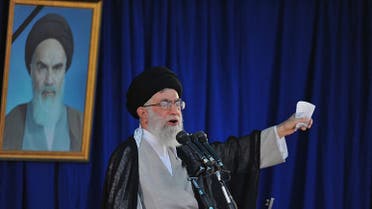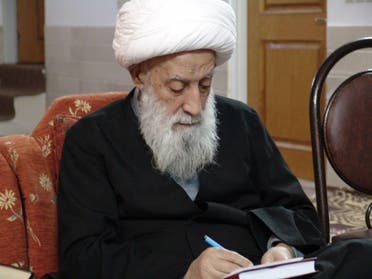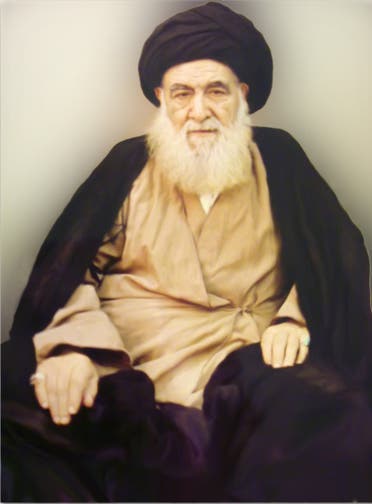Religious references and the Iranian revolution.. What is the nature of the relationship?

The death of the religious authority, Sayyid Muhammad Sadiq al-Ruhani, who passed away in the Iranian city of Qom, on Friday, December 16, re-raises a question about the nature of the relationship between the religious authorities of Shiite Muslims and the regime of the Islamic Republic in Iran, and whether these authorities are of one opinion, or are there Jurisprudential, cultural, and even political differences between it and the ruling regime, which was inaugurated by the return of Sayyid Ruhollah Musawi Khomeini, from France to Iran, in 1979, to establish a state based on the principle of “General Guardianship of the Jurist,” a position in which the current guide, Sayyid Ali Khamenei, succeeded him, shortly after. Khomeini’s death in 1989.
Shrine of Mrs. Fatima, daughter of Imam Musa Al-Kadhim
The critical jurist!
Mr. Muhammad Sadeq Al-Rouhani can be described as a “solid jurist” in his critical positions on the regime’s policies in Iran, and this is evident by reviewing his answers to some of the jurisprudential issues that he received and published on his website.
When Al-Rouhani was asked, “What is the root of your disagreement with the Islamic Republic of Iran?”, he replied, “I am one of the two main pillars for overthrowing the tyrannical, irreligious government, but rather opposed to religion and freedom (the Shah’s government). I spent several years at that time in deportation and imprisonment, and I was transferred from Prison to prison and deported to a country that is hot in the summer and very cold in the winter for the crime of defending Islam and religion and striving to form an Islamic government.I was the first to write a message about the system of government in Islam before Mr. Khomeini.But after the formation of the Islamic government a corrupt group entered the government and war broke out and disease And they wanted to remove the Shia Islamic government from its path to a non-Shiite Islamic government, so it all started in the opposition and succeeded, thank God and His grace.
So, Muhammad Sadiq al-Ruhani considers himself one of the fathers of the Iranian revolution, and that he had a hand in overthrowing the regime of the late Shah, Muhammad Reza Pahlavi, especially since he believes that “guardianship in the sense of the jurist being ruler over the Islamic nation – like the government of all presidents and kings – is an inalienable right of the jurist,” according to what he said. stated on its website; That is, he approves the intervention of the jurist in political and governmental work, in contrast to the opinions of other jurists from the school of his teacher, the late authority, Sayyid Abu al-Qasim al-Khoei, who believed that “guardianship over financial matters such as preserving the money of the absent and the orphan, if there is no one to protect it, such as the guardian or the like, then it is It is established for the jurist who collects the conditions, as well as the endowments that do not have a trustee by the endower and pleadings. The settlement of the dispute is in the hands of the jurist and the likes of that.

The guide of the revolution, Ali Khamenei
Political violence!
The dispute between Rouhani and Khomeini, and subsequently Khamenei after him, in which Rouhani was solid and strict, to the extent that he permitted the use of “violence in the political struggle,” as he published on his website, the text of which reads: “The formation of an Islamic government is a matter that is not a problem in its demand. As long as the Islamic government is in operation.” On the straight path, there is no doubt that it is not permissible to use the method of violence against anyone, but if you deviate from the straight path, either by dealing with arrogance against the Islamic nation, or by making laws that are contrary to the legal laws, or by other than that that is not compatible with the Sharia, then everyone, especially the scholars, must Guidance and display of knowledge {If innovations appear, then the scholar must display his knowledge, otherwise the curse of God will be upon him} and if he does not influence and the prohibition of evil stops on the use of violence, then this must be done. Or an unjust prince, and accordingly, the use of violence in the political struggle, if it is for what we have mentioned, then it is permissible and may be necessary, but if what we have mentioned does not apply to it, then it is not permissible. That is, al-Rouhani was one of the theorists of the rule of the clergy according to his fatwa above, and of a methodology based on a perception that many see as inconsistent with the developments of the times, and not compatible with the spirit of the civil state that many Iranians who oppose the “guardianship of the jurist” aspire to.

The late reference Sheikh Hussein Ali Montazeri
The beginnings of the dispute!
Some attribute this deep difference to a sense of “deception”. Iranian expansionism, however, Rouhani found the official Iranian government disavowing his statements, after the wave of criticism that targeted him, and that is why he felt that he had been “fooled,” according to a person familiar with him, thus accumulating differences between him and the ruling regime, which amounted to a clash between the two parties, and his situation in It is similar to “house arrest”, which is the stage that Al-Rouhani talked about by saying, “Do you know that I have been in a state of war for a long time with the previous government and the actual government, with regard to everything that I see as contrary to Sharia and Sharia, and therefore I spent more than twenty-five years of my life in confinement and confinement Home, deportation from one country to another, with forms of torture that no one can imagine.
The official eulogy!
Despite this thorny relationship with state institutions in Iran, when Muhammad Sadiq al-Rouhani passed away in the city of “Qom” where the seminary is located, the Leader of the Revolution, Ali Khamenei, built him. The late Ayatollah Hajj Al-Sayyed Sadiq Al-Rouhani, to his honorable family and the students and lovers of that honorable jurist, praying to God Almighty to bestow mercy and forgiveness on the late deceased.
More than that, Al-Rouhani had a solemn funeral, in which a wide crowd of professors and students of the seminary and a number of government officials participated. Rather, a grave was designated for him to be buried in, inside the “sanctuary of Lady Fatima Al-Masouma”, which is a religious shrine visited annually by millions of Shiite Muslims.
Between the two brothers!
Religious authority Sadiq al-Ruhani, his funeral ceremony passed quietly, unlike his late brother Sayyid Muhammad al-Husseini al-Ruhani, one of the most prominent disciples of Sayyid Abu al-Qasim al-Khoei. And who assumed the position of reference after the departure of his teacher. However, when al-Ruhani passed away in 1997, his body was prevented from being buried in the “shrine of the infallible lady,” and he was buried in his house, because of the regime’s position on him, because al-Ruhani was not in agreement with the founder of the revolution, Mr. Khomeini, since Khomeini was delivering his research on “Islamic government.” In the Iraqi city of Najaf, just as the supporters of “Khatt al-Imam” spread rumors about al-Rouhani that he was an agent of the “SAVAK” apparatus during the royal era, and this is an accusation that his brother Muhammad Sadiq denies, saying: “What is attributed to my older brother, Sayyid Muhammad (may God be pleased with him) is a lie.” pure, has no share of reality.
There is widespread dissatisfaction among the people with the bad image presented by the government and its unsatisfactory popular performance, which was subsequently reflected to include the various clerics, even those who are hostile to the regime or far from it.
informed source
Reference dumps!
Muhammad al-Husayni al-Ruhani is not the only religious authority for Shia Muslims who was buried in his house. Sayyid Muhammad al-Shirazi, who died in 2001, witnessed a great controversy and clashes between his supporters and members of the Revolutionary Guards, where al-Shirazi was subsequently buried in another place, contrary to his will. According to a source with whom Al-Arabiya.net spoke, he said, “The Shirazi religious authority recommended that he be buried in his house, and that his body be transferred to the Iraqi city of Karbala.”
It is noteworthy that Al-Shirazi, who is considered one of the founding fathers of “Shia movement Islam”, was a supporter of it at the beginning of the Iranian revolution, before becoming one of its most prominent critics.
Sheikh Hussein Ali Montazeri, who was Khomeini’s successor, before he was deposed in 1989 and placed under house arrest; When he died later, he was buried in the “shrine of Fatima Al-Masouma” in the city of Qom, despite his transformation into one of the most critical references to the way of government in Iran. However, it was customary for religious references to be buried with respect, and within the vicinity of the “maqam of infallibility”, and the regime at the time did not want a clash with the “reformist current” supporting Montazeri.
The reformists, after Montazeri’s death, chose a figure with a revolutionary history from Khomeini’s supporters, to serve as the jurist for the movement, and he is the late Sheikh Yusef Sanei, a jurist close to the approach of former President Muhammad Khatami, and he has critical positions of the “conservative” current and the guide of the revolution, Ali Khamenei.

The late religious authority, Sheikh Jawad al-Tabrizi
Bending to the storm!
Returning to Sayyid Muhammad Sadeq al-Rouhani, observers attribute the positive treatment of the official authorities in Iran with his funeral ceremony, despite his explicit critical positions of the “Islamic Republic”, to the regime’s unwillingness to clash with a wide segment of professors and students of religious sciences in the “Qom Hawza”. Where Rouhani was one of its most prominent teachers, according to the testimony of personalities such as the former head of the judiciary in Iran, Sayyid Mahmoud al-Shahrudi, who believes that “the two honest brothers are the most knowledgeable after the departure of Sayyid al-Khoei,” according to what an informed source told Al-Arabiya.net and Al-Hadath. net”.
The widespread popular demonstrations that took place in Iran, and the growing social and economic discontent of the citizens, prompted a number of scholars of the Hawza to call on the government to listen to the “voice of the people.”
After the killing of the young woman, Mahsa Amini, last September, the religious authority, Asadullah Bayat Zanjani, denounced all the “behaviors and events” that were behind “this unfortunate incident,” describing them as “illegal” and “illegal,” and adding, “The Qur’an clearly prohibits believers from using The power to impose values they consider religious and moral.”
Even pro-revolution references, such as Sheikh Hussein Nouri Hamedani, had remarkable positions, as he said that “the leaders must listen to the people’s demands, solve their problems, and show concern for their rights.”
Another pro-regime religious authority, such as Sheikh Abdullah Javadi Amoli, stated last June that “the backbone of the people is the country’s wealth, and if they cannot maintain their backbone then they are poor; their backbone has been broken.” Indicating that “the people who suffer from a broken spine do not have the strength to get up.”

The late religious authority, Mr. Abu Al-Qasim Al-Khoei
Refuse dependency!
The previous historical narration, and the different stances of several religious authorities on the “Qom Hawza” show that these personalities, in the majority of them, refuse to include the “hawza” in the ruling regime, even if it is Islamic and headed by a cleric. This position is also found among figures who support the “Islamic Republic”.
References such as the late Sheikh Jawad al-Tabrizi, as well as Sheikh Wahid al-Khorasani, who is considered today one of the most prominent professors of the Islamic seminary, and although they do not have public hostile stances against the ruling regime, they both have independent views, and they are jurisprudents who do not acknowledge the principle of “the absolute guardianship of the jurist”, but rather belong A school that does not support the involvement of religious scholars in political and partisan work.
Al-Tabrizi and Khorasani, being Iranian citizens, adopted an approach that preserves civil peace and public order, and prevents chaos or violence.
Najaf School!
These views, if the follower goes back to the sixties of the last century AD, will find roots in the positions of religious authorities and senior professors of the scientific seminary in “Najaf”. At a time when Sayyid Ruhollah al-Musawi Khomeini was delivering his jurisprudence lessons and political speeches in Najaf, and delegations of supporters came to him from Iran, weighty references with a great scholarly and popular presence, such as Sayyid Muhsin al-Hakim, Sayyid Abu al-Qasim al-Khoei, and Sayyid Mahmoud al-Shahrudi, were conservative on the political approach. Khomeini, and some of them even warned his students of the ideas of the owner of the “Islamic government”, and advised them to stay away from it, without denying Khomeini his philanthropy or religious authority. However, the approach that the Najaf Hawza followed at the time, and which extended for decades, disapproved of political work or the involvement of religious scholars in parties or their appointment to official positions, and they consider that a “great evil”!
A chance to break free!
The researcher specializing in Iranian affairs, Hassan Fahs, in a paper published by the “Independent Arabia” website, December 15, entitled “Stations on Iran’s Long Road,” in which he indicated that “what is happening and what the position of the Guardian Jurist is exposed to is an opportunity to restore the margin of independence that was The seminary enjoys and is distinguished by it, thus departing from the framework previously drawn by the guide for these seminaries. This is evident by holding a number of professors of the seminary, the organs of the regime, “responsible for the disrespect and insult to the turban that confronted several religious scholars in the public street,” according to what an informed source expressed to Al-Arabiya.net and Al-Hadath.net. He added, “There is widespread dissatisfaction among people with the bad image presented by the government and its unsatisfactory popular performance, which was subsequently reflected to include various clerics, even those who are hostile to the regime or far from it.”
Accordingly, the relationship between the seminary in Qom and the ruling regime in Iran is not characterized by dependence and absolute obedience. Rather, there have been ebbs and flows for more than forty years, during which the supporters of the “line of the imam” sought attempts to politicize and revolutionize the seminary, while the traditional references remained an impenetrable barrier in front of them. Many personalities paid the price for that, among those whose religious garb was removed, such as the late Sayyid Kazem Sharia Madari, or whose scope of movement was restricted, such as Sayyid Hassan al-Qummi; While the supporters of Mr. Khomeini’s ideas enjoyed a wider margin in work and teaching, such as the late Sheikh Al-Fadil Lankarani and Sheikh Nasser Makarem Shirazi.
xnxx,
xvideos,
porn,
porn,
xnxx,
Phim sex,
mp3 download,
sex 4K,
Straka Pga,
gay teen porn,
Hentai haven,
free Hentai,
xnxx,
xvideos,
porn,
porn,
xnxx,
Phim sex,
mp3 download,
sex 4K,
Straka Pga,
gay teen porn,
Hentai haven,
free Hentai,


